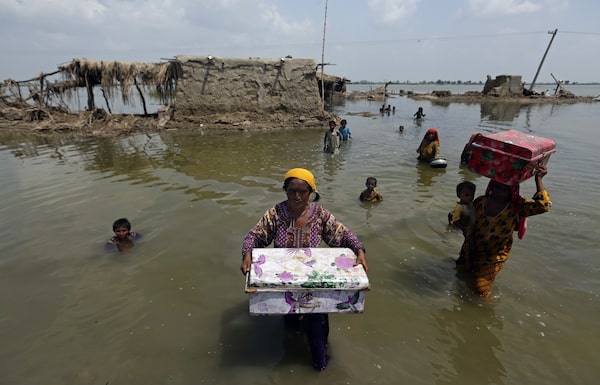
Women carry belongings salvaged from their flooded home after monsoon rains, in Pakistan on Sept. 6.Fareed Khan/The Associated Press
Record high temperatures in urban Europe as heat waves bake the planet more often. Devastating floods, some in poorer unprepared areas. Increasing destruction from hurricanes. Drought and famine in poorer parts of Africa as dry spells worsen across the globe. Wild weather worldwide getting stronger and more frequent, resulting “in unprecedented extremes.”
Sound like the last few summers?
It is. But it was also the warning and forecast for the future issued by top United Nations climate scientists more than 10 years ago.
In a report that changed the way the world thinks about the harms of global warming, the Intergovernmental Panel on Climate Change’s special report on extreme events, disasters and climate change warned in 2012: “A changing climate leads to changes in the frequency, intensity, spatial extent, duration, and timing of extreme weather and climate events, and can result in unprecedented extreme weather and climate events.” It said there would be more heat waves, worsening droughts, increasing downpours causing floods and stronger and wetter tropical cyclones and simply nastier disasters for people.
“The report was clairvoyant,” said report co-author Michael Oppenheimer, a Princeton University climate scientist. “The report was exactly what a climate report should do: Warn us about the future in time for us to adapt before the worst stuff happens. And the world proceeded to do what it usually does. Some people and governments listened, others didn’t. I think the sad lesson is the damage has to occur very close to home or else nobody pays attention now.”
In just the United States alone, the number of weather disasters that cost at least $1-billion in damage – adjusted for inflation – went from an average of 8.4 a year in the decade before the report was issued to 14.3 a year after the report came out, with more than a trillion dollars in U.S. weather damage since in just the billion-dollar extremes, according to the National Oceanic and Atmospheric Administration. Unprecedented record heat hit Northern California in September and 104 degrees in England (40 degrees Celsius) earlier this summer.
The 594-page report’s 20-page summary highlighted five case studies of climate risks from worsening extreme weather that scientists said will be more of a problem and how governments could deal with them. In each case scientists were able to give a recent example:
- Flash floods in “informal settlements.” Look at flooding in poor sections of Durban, South Africa, this year, said report co-author and climate scientist Maarten van Aalst, director of the International Red Cross and Crescent Climate Centre in the Netherlands. Or Eastern Kentucky or the Pakistan this year or Germany and Belgium last year, report authors said.
- Heat waves in urban Europe. “We’ve got that one in spades. That’s been consistent,” said Susan Cutter, a University of South Carolina disaster scientist. “I think every year there have been longer periods of heat in Europe.”
- Increasing property losses from hurricanes in the United States and the Caribbean as storms get wetter and stronger, but not more frequent. Oppenheimer pointed to the last few years when Louisiana has been smacked repeatedly by hurricanes, last year when Hurricane Ida killed people in New York because of heavy rainfall flooding basement apartments and 2017 when record rain from Hurricane Harvey paralyzed Houston and Hurricane Maria devastated Puerto Rico with Hurricane Irma in between.
- Droughts causing famine in Africa. That’s happening again in the Horn of Africa and last year in Madagascar, Mr. van Aalst said.
- Small islands being inundated by a combination of sea level rise, saltwater intrusion and storms. That’s tougher, but co-author Kris Ebi, a University of Washington climate and health scientist, pointed to record strong Tropical cyclone Winston striking Vanuatu and Fiji in 2016.
“Right now people are feeling it,” Mr. van Aalst said. “It’s no longer the science telling them. All those warnings came true.”
In fact, reality has likely been worse, with more and stronger extremes than the authors would have predicted when they finished writing it in 2011 and published it a year later, said co-authors Ms. Ebi and Ms. Cutter.
That’s partly because when real life played out, disasters compounded and cascaded with sometimes unforeseen side effects, like heat waves and droughts causing hydroelectric power plants to dry up, nuclear power plants unable to get cooling water and even coal power plants not getting fuel deliveries because of dried rivers in Europe, scientists said.
“Imagining something scientifically or saying this exists in a scientific assessment is a radically different thing compared to living it,” said co-author Katharine Mach, a climate risk scientist at the University of Miami. She said it was similar to the COVID-19 pandemic. Health officials had long warned of viral pandemics but when it came true, the lockdowns, school closures, economic consequences, supply chain problems were sometimes beyond what dry scientific reports could envision.
Before this report, the overwhelming majority of climate studies, official reports and debate talked about long-term consequences, the slow but steady rise in average temperatures and sea level rise. Extreme events were considered too rare to study to get good statistics and science and wasn’t seen as a big issue. Now much of the focus in science, international negotiations and media coverage is about climate change extremes.
Stanford University climate scientist Chris Field, who led the report project a decade ago, said the scientists got the warnings right, but “we may have been too conservative” in the language used. In addition to the dry facts and figures presented he wishes he had used wording that would be “grabbing people by the shoulders and shaking them a little bit more and saying these are real risks.”
Our Morning Update and Evening Update newsletters are written by Globe editors, giving you a concise summary of the day’s most important headlines. Sign up today.